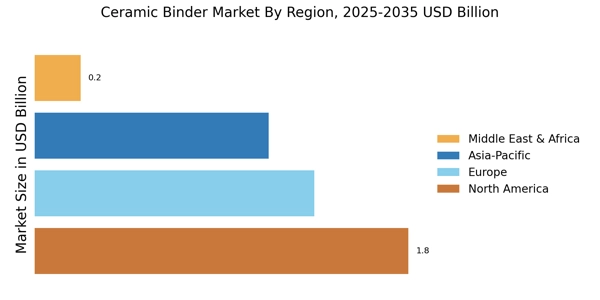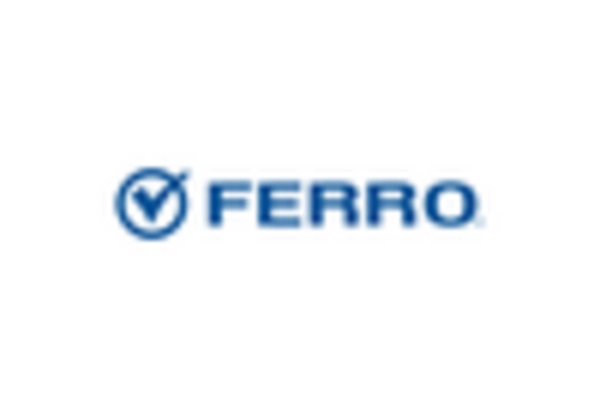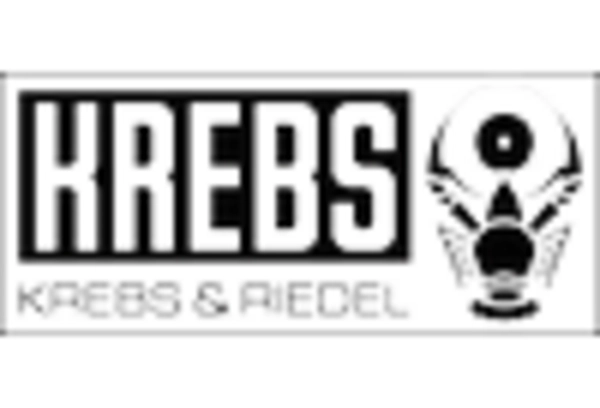Expansion of the Automotive Sector
The Ceramic Binder Market is also benefiting from the expansion of the automotive sector. As automotive manufacturers increasingly adopt advanced materials for components, the demand for ceramic binders is expected to rise. Ceramic binders are utilized in various applications, including brake pads and engine components, due to their high thermal resistance and durability. The automotive industry is projected to grow at a compound annual growth rate of approximately 4% in the coming years, which could significantly impact the Ceramic Binder Market. This growth presents opportunities for manufacturers to innovate and develop specialized ceramic binders tailored for automotive applications, thereby enhancing their market presence and driving revenue growth.
Rising Demand in Construction Sector
The Ceramic Binder Market is experiencing a notable surge in demand, primarily driven by the construction sector. As urbanization accelerates, the need for durable and aesthetically pleasing materials has increased. Ceramic binders are favored for their strength and resistance to environmental factors, making them ideal for various applications, including tiles and bricks. According to recent data, the construction industry is projected to grow at a compound annual growth rate of approximately 5.5% over the next few years. This growth is likely to bolster the Ceramic Binder Market, as manufacturers seek to meet the rising demand for high-quality construction materials. Furthermore, the trend towards sustainable building practices may further enhance the appeal of ceramic binders, as they are often derived from natural materials and can contribute to energy-efficient building designs.
Growing Interest in Eco-Friendly Materials
The Ceramic Binder Market is witnessing a shift towards eco-friendly materials, driven by increasing environmental awareness among consumers and industries. As sustainability becomes a priority, manufacturers are exploring the use of natural and recycled materials in the production of ceramic binders. This trend aligns with the broader movement towards sustainable construction practices, where the demand for environmentally friendly products is on the rise. Data indicates that the market for sustainable building materials is expected to expand significantly, with a projected growth rate of around 7% annually. This growing interest in eco-friendly materials is likely to create new opportunities for the Ceramic Binder Market, as companies that prioritize sustainability may gain a competitive edge and attract environmentally conscious consumers.
Technological Innovations in Manufacturing
Technological advancements are playing a pivotal role in shaping the Ceramic Binder Market. Innovations in manufacturing processes, such as the development of advanced mixing and curing techniques, are enhancing the quality and performance of ceramic binders. These technologies enable manufacturers to produce binders with improved properties, such as higher thermal stability and better adhesion. Additionally, the integration of automation and digitalization in production lines is streamlining operations, reducing costs, and increasing efficiency. As a result, companies are better positioned to respond to market demands and customize products to meet specific client needs. The ongoing investment in research and development is expected to further propel the Ceramic Binder Market, as new formulations and applications are explored, potentially leading to a broader range of products available in the market.
Increased Investment in Research and Development
Investment in research and development is a critical driver for the Ceramic Binder Market. As competition intensifies, companies are allocating resources to innovate and improve their product offerings. This focus on R&D is leading to the development of new ceramic binder formulations that offer enhanced performance characteristics, such as improved adhesion and resistance to heat and chemicals. Furthermore, collaboration between manufacturers and research institutions is fostering the exploration of novel applications for ceramic binders across various industries, including construction, automotive, and electronics. The emphasis on R&D is expected to yield significant advancements in the Ceramic Binder Market, potentially resulting in a wider array of products and applications that meet evolving market demands.


















Leave a Comment